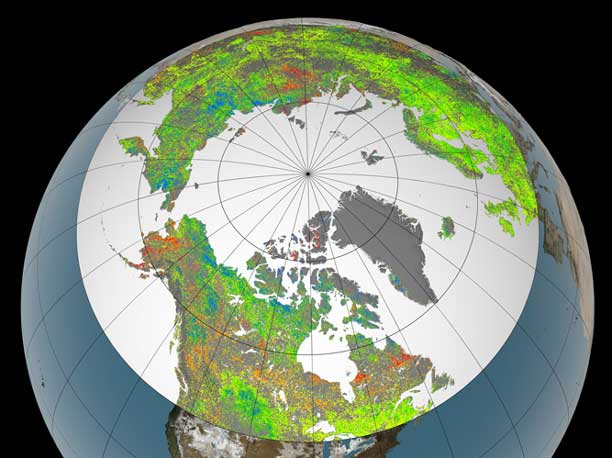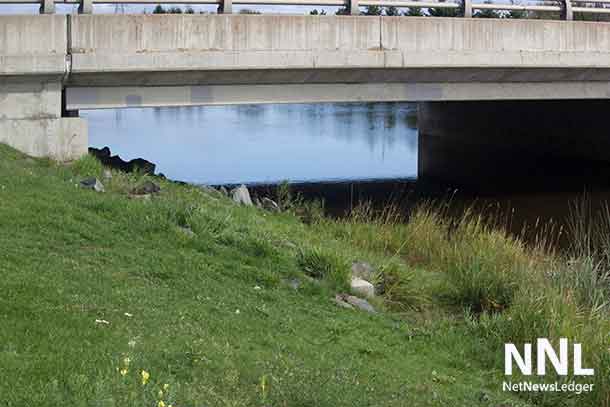

Credit: NASA’s Goddard Space Flight Center Scientific Visualization Studio
THUNDER BAY – Technical – Life on Earth is tied to seasonal changes. As people adapt to the shift to ‘Day Light Savings’, it is a good time to look at how changes in climate impact life. Changes in the climate are being studied, and are having an impact on the Northern Hemisphere. As a result of enhanced warming and a longer growing season, large patches of vigorously productive vegetation now span a third of the northern landscape, or more than 3.5 million square miles (9 million square kilometers). That is an area about equal to the continential United States. This landscape resembles what was found 250 to 430 miles (400 to 700 kilometers) to the south in 1982.
Life on Earth – Seasons and Vegetation
“It’s like Winnipeg, Manitoba, moving to Minneapolis-Saint Paul in only 30 years,” said co-author Compton Tucker of NASA’s Goddard Space Flight Center in Greenbelt, Md.
“The way of life of many organisms on Earth is tightly linked to seasonal changes in temperature and availability of food, and all food on land comes first from plants,” says Dr. Scott Goetz, Deputy Director and Senior Scientist, Woods Hole Research Center, Falmouth, USA. “Think of migration of birds to the Arctic in the summer and hibernation of bears in the winter: Any significant alterations to temperature and vegetation seasonality are likely to impact life not only in the north but elsewhere in ways that we do not yet know.”
An international team of 21 authors from 17 institutions in seven countries has just published a study in the journal Natural Climate Change showing that, as the cover of snow and ice in the northern latitudes has diminished in recent years, the temperature over the northern land mass has increased at different rates during the four seasons, causing a reduction in temperature and vegetation seasonality in this area. In other words, the temperature and vegetation at northern latitudes increasingly resembles those found several degrees of latitude farther south as recently as 30 years ago. The study, titled “Temperature and vegetation seasonality diminishment over northern lands” (DOI: 10.1038/NCLIMATE1836), can be downloaded here: http://dx.doi.org/.
The NASA-funded study, based on newly improved ground and satellite data sets, examines critically the relationship between changes in temperature and vegetation productivity in northern latitudes.
On the amplified greenhouse effect, Prof. Ranga Myneni, Department of Earth and Environment, Boston University and lead co-author says “A greenhouse effect initiated by increased atmospheric concentration of heat-trapping gasses—such as water vapor, carbon dioxide and methane—causes the Earth’s surface and nearby air to warm. The warming reduces the extent of polar sea ice and snow cover on the large land mass that surrounds the Arctic ocean, thereby increasing the amount of solar energy absorbed by the no longer energy-reflecting surface. This sets in motion a cycle of positive reinforcement between warming and loss of sea ice and snow cover, thus amplifying the base greenhouse effect.”
Amplified warming in circumpolar area
“The amplified warming in the circumpolar area roughly above the Canada-USA border is reducing temperature seasonality over time because the colder seasons are warming more rapidly than the summer,” says Liang Xu, a Boston University doctoral student and lead co-author of the study.
“As a result of the enhanced warming over a longer ground-thaw season, the total amount of heat available for plant growth in these northern latitudes is increasing. This created during the past 30 years large patches of vigorously productive vegetation, totaling more than a third of the northern landscape—over 9 million km2, which is roughly about the area of the USA— resembling the vegetation that occurs further to the south,” says Dr. Compton Tucker, Senior Scientist, NASA’s Goddard Space Flight Center, Greenbelt, Maryland.
The authors measured seasonality changes using latitude as a yardstick. They first defined reference latitudinal profiles for the quantities being observed and then quantified changes in them over time as shifts along these profiles.
“Arctic plant growth during the early-1980s reference period equaled that of lands north of 64 degrees north. Today, just 30 years later, it equals that of lands above 57 degrees north—a reduction in vegetation seasonality of about seven degrees south in latitude,” says co-author Prof. Terry Chapin, Professor Emeritus, University of Alaska, Fairbanks. “This manner of analyses suggested a decline in temperature and vegetation seasonality of about four to seven degrees of latitude during the past 30 years,” says co-author Eugenie Euskirchen, Research Professor, University of Alaska, Fairbanks.
“The reduction of vegetation seasonality, resulting in increased greenness in the Arctic, is visible on the ground as an increasing abundance of tall shrubs and tree incursions in several locations all over the circumpolar Arctic,” says co-author Terry Callaghan, Professor, Royal Swedish Academy of Sciences and the University of Sheffield, UK. He notes that the greening in the adjacent Boreal areas is much less conspicuous in North America than in Eurasia.
A key finding of this study is an accelerating greening rate in the Arctic and a decelerating rate in the boreal region, despite a nearly constant rate of temperature seasonality diminishment in these regions over the past 30 years. “This may portend a decoupling between growing season warmth and vegetation productivity in some parts of the North as the ramifications of amplified greenhouse effect—including permafrost thawing, frequent forest fires, outbreak of pest infestations, and summertime droughts—come in to play,” says co-author Hans Tømmervik, Senior Researcher, Norwegian Institute for Nature Research, Tromsø, Norway.
According to the authors, the future does indeed look troubling: Based on analysis of 17 state-of-the-art climate model simulations, diminishment of temperature seasonality in these regions could be more than 20 degrees in latitude by the end of this century relative to the 1951-1980 reference period. The projected temperature seasonality decline by these models for the 2001-2010 decade is actually less than the observed decline. “Since we don’t know the actual trajectory of atmospheric concentration of various agents capable of forcing a change in climate, long-term projections should be interpreted cautiously,” says co-author Bruce Anderson, Professor of Earth and Environment at Boston University.
“These changes will affect local residents through changes in provisioning ecosystem services such as timber and traditional foods,” says Research Professor Bruce Forbes, University of Lapland, Rovaniemi, Finland. They will also impact the global community through changes in regulatory ecosystem services relating to emissions of greenhouse gases. “The soils in the northern land mass potentially can release significant amounts of greenhouse gases which are currently locked up in the permanently frozen ground. Any large-scale deep-thawing of these soils has the potential to further amplify the greenhouse effect,” says co-author Philippe Ciais, Associate Director, Laboratory of Climate and Environmental Science, Paris, France.






